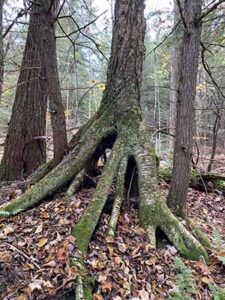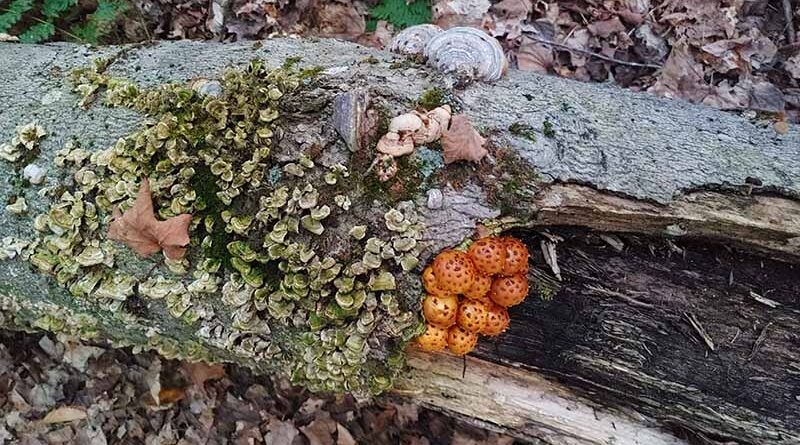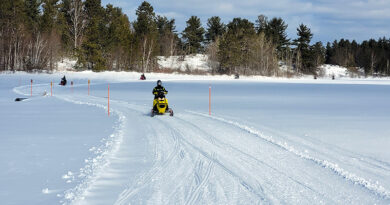Embrace the Mess!
It takes a concerted effort to shed the shackles of our Victorian era perspective when it comes to the beauty we see in outdoor environments. The tastefully cut lawn and manicured gardens have an appeal that lies more in our sense of aesthetics than a healthy ecosystem. A healthy forest, on the other hand, is messy. Dead standing trees, tangles of bush, rotting logs and leaf litter strewn about in an untidy and chaotic fashion are all indicators of good forest health.
As a hike leader, whenever I get the chance, I like to share the characteristics of a healthy forest with participants. I often introduce the role of decomposition in forest ecology while standing next to a fallen log, sharing the following joke/story:
Early in my international backpacking days, I decided to travel to Austria to visit the tomb of the famous composer Mozart. I was able to find it but was completely puzzled by the strange sounds coming from his tomb. So, I went over to a groundskeeper who was working nearby and asked him about it.
“Hey, just wondering, do you know anything about the strange sounds coming from Mozart’s tomb?”
“Oh… yes, that’s Mozart de-composing.”
I know, a real groaner, but it works as a light hearted segue into the roles that a tree plays when it is no longer living. By the time a tree dies, it has only partially fulfilled it ecological function. Considered by biologists as the “hot spot” of the forest ecosystem, downed logs are essential to maintain forest biodiversity amongst other important ecological roles.
Surprisingly, there are more living cells in a dead tree, than a live one as microbial life flourishes. Mostly made up of fungi, insects and bacteria, these invisible dead log inhabitants are the catalyst of decomposition and the transformation of the log back to soil for future generations of plant life.
Downed tree trunks are reservoirs for moisture and foster the growth of mycorrhizal fungi which plays an important role in an underground nutrient sharing network. Spiders, beetles, ants, grubs, worms, snails, and slugs found inside rotting logs are food for animals such as snakes, birds, mice, and bears.
Small mammals such voles, mice and shrews use rotting logs as nesting sites and protection from predators. Squirrels and chipmunks use logs on the ground as part of their travel pathways for safe escape and elevated feeding platforms. Moisture retaining logs make them natural cooling cover sites for wet-skinned amphibians like salamanders and frogs.
Logs, stumps and root balls also act as “nurseries” for plants. Stumps and logs progress through their own natural succession, with fungi and mosses establishing themselves early, followed by ferns. A thin veneer of soil will eventually form a nutrient-rich landing pad for tree seeds to establish roots. On your hikes, look for yellow birch and hemlock trees that use these nursing logs as ideal places for their small seeds to sprout. After the log or stump rots out, the roots are left elevated like a tree on stilts.
Dead standing trees, call snags, also provide an important ecological role as multifunctional forest high rises. Often taken down for safety reasons, snags should be left standing whenever possible for many reasons.

Whether bored out by woodpeckers or developing naturally through decay or branch mortality, tree cavities provide an important ecological function in the forest. The list of cavity users is extensive and includes the saw-whet owl, barred owl, and kestrel, as well as several species of waterfowl including the common goldeneye and wood duck. Many songbirds, including eastern bluebird, great-crested flycatcher, black-capped chickadee and white breasted nuthatch are also cavity users.
Various mammals also rely on tree cavities. They include deer mice, bats, martens, fishers and squirrels. I once was leading a canopy tour at Haliburton Forest and Wild Life Reserve when we came across a raccoon in a large tree cavity sleeping off an all-nighter. With no leaves or needles, birds of prey use snags as perches giving them a clear view of prey below. In Ontario, up to 50 birds and mammals have been identified that rely on snag cavities for nesting, rearing young, roosting, feeding, storing food, perching, escaping predators or hibernating.
Like a teenager’s bedroom (if you have one of those), the thriving forest will also be in a state of disorder. No nicely rounded or straight edges to please the eye, a forest flourishes in the seemingly chaotic process of forest aging and environmental disturbance. So, on your summer hikes, look deep into the forest and embrace the mess because messy is a sign of forest health.
Submitted by Rick Whitteker. You can find Rick at home in the forest, as a seasoned trail guide, nature writer and passionate wildlife enthusiast in the Haliburton Highlands.
Photo Credits: Log – Ralph Baehre, Yellow Birch on stilts – Rick Whitteker, Fly squirrel – Paul Heaven




